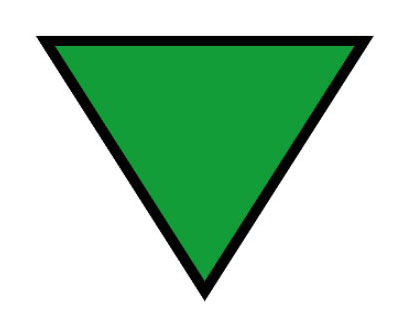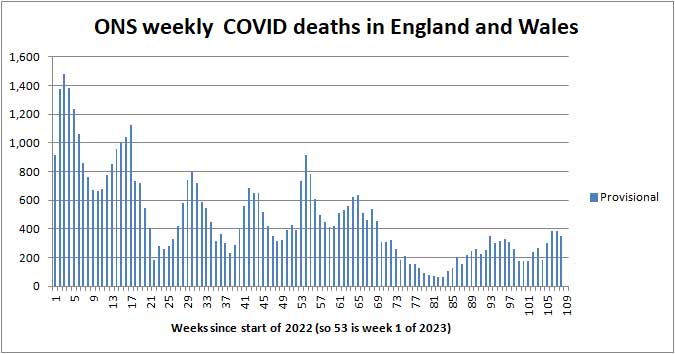
Angus and Rosemary's Miscellany
of Malvern - Other Resources
|
Occasional Coronavirus (COVID-19) update for Malvern SeniorsClick to read our observations on politics and world events 5th February 2024 PreambleCases rose during Christmas, but are now declining. Deaths are currently only one sixth of those related to Influenza and Pneumonia so the ONS has reclassified COVID as a minor cause of death. Consequently this may be our last 'occasional' update. The Coronavirus Dashboard has been retired. Though a summary of the figures can still be found on The UKHSA data dashboard some of the data seems well behind real time and one wonders whether it receives much attention. NHS England hospital admissions and beds; and deaths reported by ONS are the principal remaining measures of COVID-19 in the UK as COVID-19 descends into the soup of respiratory viruses. ContentsSummaryThere was a rise in cases, caused by mingling over Christmas, leading to a small increase in hospitalizations and deaths during January; cases are however now falling, albeit slowly, and this trend is expected to continue during the spring and summer. Though the Autumn booster campaign ended on 15th December 2023, a further opportunity for COVID vaccination is expected later in 2024. The government may limit this to those aged over 75 years in order to reduce the cost. What happens if you get sickIf you are feeling poorly it might not be COVID-19 but quite likely some other respiratory illness. Whatever the virus best stay at home until you feel better, and wear a face mask to protect others if you do have to go out. You can still test for COVID at home using Lateral Flow Self-Testing Kits. These are no longer free but additional kits can often be purchased from pharmacies. If concerned, you can purchase an Oximeter to measure your Oxygen levels at home, but note these can give erratic readings if your pulse is weak and hands are cold, so don't panic and take a number of readings if you are worried. If you catch COVID it is likely to be a 'mild' illness, though you might feel very poorly for two weeks and be left feeling very tired after; the unlucky few might suffer breathing difficulties and become severely ill. (Definitions: mild = treatable at home; severe = treated in hospital). Patients are advised to take it easy until fully recovered; some have suggested that overdoing it might even damage your health. A small percentage of patients have suffered from Long COVID, to a greater or lesser extent, and some of these have been unable to go back to work. PrecautionsMany of those catching COVID often have little idea of where or who they caught COVID from, although groups of people catching COVID at the same time following an event, such as a conference or wedding, have a very good idea! Few people are now taking precautions; most people no doubt depending on either vaccination or previous infection to protect against serious illness. UKHSA is no longer publishing data on the benefits of vaccination versus side-effects; one can only trust the vaccines offered by the NHS provide some protection from the latest variants. Vaccination SitesVaccination ceased to be offered by the NHS on 15th December 2023. Click to book, cancel or change a COVID-19 vaccination appointment (You cannot currently book with this link, but opportunities may arise later in 2024) Number of casesWidespread monitoring of daily COVID cases has ceased in the UK. Number of deathsONS figuresThe Office of National Statistics (ONS) reports registered deaths in England and Wales where COVID-19 is mentioned somewhere on the death certificate. The ONS figures lag real time by 10 - 14 days due to the administrative delay in submitting and processing reports, and do not include Northern Ireland and Scotland. For 2023 figures you can click:- ONS 2023 data on deaths (Excel spreadsheet) For 2024 figures click:- ONS deaths registered weekly in England and Wales, provisional 2024 then click the Table 3 tab to view a breakdown of deaths.
|
| Age band | Number of COVID deaths | % of deaths |
| 0 - 19 | 8 | 0.3 |
| 20 - 39 | 25 | 0.9 |
| 40 - 59 | 165 | 5.7 |
| 60 - 79 | 1,010 | 34.9 |
| 80+ | 1,692 | 58.4 |
Relative risk of COVID-19 death by age band May - July 2022
The main point to note is those aged 60+ account for 93% of deaths despite young people being more likely to catch COVID-19.
The risk profile for Omicron appears to be the same as for Delta. Age is still the greatest risk factor; perhaps reflecting that older people have more health problems.
According to the Coronavirus Dashboard sex is an additional risk factor - males are roughly 50% more likely to die than women; possibly because women have a stronger immune system.
 Healthcare numbers
Healthcare numbers
Bed numbers by region in England
Tabulated figures for COVID bed occupancy in England can still be found on the NHS England website providing another indicator of the prevalence of COVID.
Click for NHS England COVID-19 Hospital bed Activity statistics
Note: see the latest Weekly Admissions and Beds spreadsheet, then select All beds COVID tab.
| Region | 31st December 2023 | 4th February 2024 | 15th January 2021 |
| England | 4,114 | 3,319 | 33,362 |
| London | 800 | 607 | 7,811 |
| Midlands | 776 | 683 | 5,890 |
Comparison of All beds COVID data for England, London and Midlands
The number of patients in the Midlands in hospital with COVID peaked at 835 towards the end of January 2024 and is slowly falling.
For comparison, the number of beds occupied during the peak of the epidemic in January 2021 is shown in red in the right hand column of the table.
Charts can be found on The UKHSA data dashboard
Forecast for the week ahead
The numbers are changing slowly so expect little change week to week.
Longer term outlook
There was a lot of COVID about before Christmas, but little mention now. While it can make people feel very poorly, relatively few are being admitted to hospital.
The frequency of COVID is expected to decline further during the spring and summer, returning next winter, like Influenza.
Note: when considering where to mingle, bear in mind that your surgery in hospital could be delayed were you to catch COVID.
Advice for Seniors
Apart from booster programmes, the government has largely washed its hands of COVID considering it to be just one of many respiratory viruses in circulation.
Little or no recent statistical information about the benefits of booster vaccinations and the health risks posed by the latest variants in circulation has been published.
The risk of exposure to COVID remains fairly high but there is no evidence that COVID is causing significant numbers of people in Worcestershire to fall severely ill; so for most, the risk is now probably very LOW.
Consequently our riskometer remains at LOW (see opposite).
Most healthy people are taking the view that COVID is no longer a critical threat to their health.
For the more cautious the simple safeguards to protect against all respiratory infections are to:
-
make sure vaccinations are up to date - (when offered)
-
wash HANDS thoroughly, using soap and hot water, for 20 seconds, including after handling deliveries to your home, to kill virus picked up from contaminated surfaces (see note 1);
-
wear either a well fitting FACE covering, or better still an FFP2 (N95) face mask when in crowded settings for example when in shops, theatres, health-care settings, using public transport, and travelling by air;
-
SPACE at least 2 metres from people you don't feel safe with (see note 2), remembering when people are at their most infectious many do not show symptoms.
-
preferably socialise with friends and other households outdoors in the FRESH AIR else, if you are indoors, either ventilate by keeping windows open as far as is practicable or consider putting a HEPA air purifier in the room;
-
avoid crowded indoor settings, people shouting and singing, and friends and colleagues with cold and flu like symptoms;
-
stay at home to protect others if you yourself feel unwell with cold or flu like symptoms;
-
respect others and give them space;
Notes:
1) Wash your hands thoroughly before touching your face to avoid transferring virus from contaminated surfaces to your mouth, eyes and nose. If outdoors, for example filling the car up with fuel, either wash hands with an alcohol based hand gel after touching suspect surfaces or wear gloves.
2) Two metres is further than you think - roughly an arm and a walking stick away.
3) If you are 'clinically vulnerable' consult your GP or specialist; you may need to take a test and consider anti viral drugs if testing positive.
Annex
Commentary
The COVID-19 pandemic which emerged in China at the start of 2020 is over.
For many of us, COVID-19 now seems a distant memory, seemingly happening a long time ago. We are the survivors, the lucky ones; but we should not forget that others are still remembering the loved ones they lost.
Some unlucky adults and children remain casualties having become disabled to a greater or lesser extent, possibly unable to work or attend school.
The education of children at school and teenagers at university was severely disrupted.
Business owners lost money, and sometimes their business.
Hospital doctors and nurses, and those supporting them, will no doubt carry vivid and long-lasting memories of the pandemic, the pressures they were under, and patients they lost, especially during that first YEAR THE WORLD WENT MAD.
The somewhat boring UK Inquiry into the pandemic grinds on. Click UK COVID-19 Inquiry for more information.
List of vaccines
Section deleted. Refer to archived pages for historical information about vaccines.
Summary of Links
A lot of this information is now out of date, some links are broken, but working links may provide a historical context to the epidemic.
Information about Coronavirus can be found on the NHS website:
https://www.nhs.uk/coronavirus
Symptoms
Note: the list of symptoms was updated on 1st April 2022
Article about the effects of Wuhan Coronavirus on the human body
Reporting and how to obtain a test
How to get a test
https://www.nhs.uk/coronavirus
About joining the Zoe COVID Symptom Study:
Guidance
UK government Coronavirus guidance
See also - government sets out next steps for living with COVID
COVID-19 Response: Autumn and Winter Plan 2021 for England
UK Health and Security Agency (UKHSA) website
COVID Alert states
Guidance on UK COVID-19 alert level methodology: an overview
COVID-19 Alert Level lowered to 3 on 10th May 2021
Tiers
Guidance on tiers: what you need to know
Government postcode checker to find tier for other areas
Statistics
The UKHSA data dashboard (new source of data on COVID and Flu)
UK government COVID-19: Omicron daily overview
UK government Coronavirus Dashboard (retired)
Coronavirus Dashboard Interactive Map
ONS data on deaths in England and Wales (Excel spreadsheet, data up to the end of 2023)
For later figures see:-
ONS deaths registered weekly in England and Wales, provisional 2024
Select table 3 for weekly provisional death registrations for selected causes of death by country and region, in England and Wales. Figures are given for both COVID related deaths, and where COVID was the primary cause of death.
Note: ONS say that due to the low numbers of COVID-19 deaths (fewer than influenza or pneumonia), detailed breakdowns by age and place of occurrence are no longer included in the 2024 edition of this dataset.
NHS England COVID-19 Daily Deaths
NHS England COVID-19 Hospital Admissions
NHS England vaccination statistics
Worcestershire Coronavirus Dashboard (retired)
Worcestershire COVID-19 Vaccinations Dashboard
HSA COVID-19 vaccine weekly surveillance reports
Information about NHS hospital bed numbers: past, present, future
A glimpse of the worldwide vaccination situation can be found on the Our World in Data website.
Click for chart showing % vaccinated
A video with Dr John Campbell and mathematician Professor Fenton explaining the various ways in which RISK can be specified.
Risks and benefits with Professor Fenton
Modelling
A forecast of the progression of the COVID-19 epidemic can be found on a University College London (UCL) website.
Click for UCL Long-term forecasting of the COVID-19 epidemic
A projection of the future COVID-19 death toll and daily deaths can be found on The Institute for Health Metrics and Evaluation website.
Click for IHME projection of COVID-19 deaths
Reports
Coronavirus (COVID-19) latest insights by ONS
A live roundup of the latest data and trends about the coronavirus (COVID-19) pandemic from the ONS and other sources.
MedRxiv is a US preprint server for Health Sciences. A depository for reports which have still to be peer reviewed.
COVID-19 rapid guideline: managing the long-term effects of COVID-19
NICE guidance on managing Long COVID
The bigger picture
Worldometer summary of coronavirus cases worldwide
European Centre for Disease Prevention and Control info
https://www.ecdc.europa.eu/en/geographical-distribution-2019-ncov-cases
World Health Organisation info
Window on the USA
Centre for Disease Control (CDC)
Find maps and charts tracking cases, deaths, and trends of COVID-19 in the United States.
American Association of Retired People (AARP)
Worcestershire
A local summary of COVID data can be found on the Worcestershire Coronavirus Dashboard.
Note 1: use the arrow <> buttons at the bottom of the Dashboard screen to move between pages.
Note 2: the figures for COVID cases are becoming meaningless as testing is run down.
Note 3: deaths are on page 7, and hospital beds on page 9.
Click for Worcestershire County Council COVID-19 news
There is a colourful webpage offering advice on learning to live with COVID for those aged under 30 years. 'Rona' is slang for Coronavirus.
Click for The Worcestershire 'Rona' Hub
Click for Simple Summary of Malvern numbers on the Coronavirus dashboard
Miscellaneous
Spanish Flu
Dr Jeff Kildea's commentary about the 1919 outbreak of Spanish Flu in Australia
Views of Martin McKee, Professor of European Public Health
Follow Martin McKee on Twitter
Views of Prof Christina Pagel, a member of Independent SAGE
Follow Christina Pagel on Twitter
SAGE membership
Scientific Advisory Group for Emergencies (SAGE)
Scottish government:
Link to Scottish Government website
Link to Postcode checker for COVID restrictions by protection level in areas of Scotland
Welsh Government:
Guidance on COVID alert levels in Wales
Bibliography
Woolhouse, Professor Mark, The Year the World went Mad, published 2022 by Sandstone Press Ltd, ISBN: 978-1-913207-94-3
Medinger Dez, Altmann Danny, The Long Covid Handbook, Penguin Books, 2022. Kindle version available.

The interpretations and opinions expressed are our own
Last updated 5th February 2024
 Blogs
>
Blogs
>